Batfish Introduction

One of the problems of modern networks is their fragility. Many filtering rules, routing information exchange policies, dynamic routing protocols make the networks confusing and subject to human factors. An accident on the network may occur unintentionally when making changes to the route-map or ACL ( one , two ). We have determined that there is not enough tool to evaluate the behavior of the network with the new configuration before making changes to the production. I want to know for sure if network A will be available to me if I filter out a part of the BGP announcements received from provider B? What route will the packets from network C go to server D, if on one of the transit links I double the IGP metric? Batfish will help us to answer these and many other questions!
Batfish Review
Batfish is a network modeling tool. Its main purpose is to test configuration changes before entering them into the work network. Batfish can also be used to analyze and check the current network status. Existing CI / CD processes in the networked world are clearly lacking a tool for testing new configurations. Batfish solves this problem.
Batfish does not require direct access to existing network equipment; Batfish models network behavior based on the data contained in the device configuration files.
')
Batfish can:
- determine the status of the neighborhood network dynamic routing protocols (BGP, IS-IS, OSPF)
- calculate the RIB of each network element
- check NTP, AAA, MTU settings
- allow you to determine if the ACL blocks network traffic (analogous to the packet-tracer on the Cisco ASA)
- check for end-to-end connectivity between hosts within the network
- show the path of traffic through the network (virtual tracing)
Supported Platforms:
- Arista
- Aruba
- AWS (VPCs, Network ACLs, VPN GW, NAT GW, Internet GW, Security Groups)
- Cisco (NX-OS, IOS, IOS-XE, IOS-XR and ASA)
- Dell force10
- Foundry
- iptables
- Juniper (MX, EX, QFX, SRX, T-series, PTX)
- MRV
- Palo alto networks
- Quagga / FRR
- Quanta
- Vyos
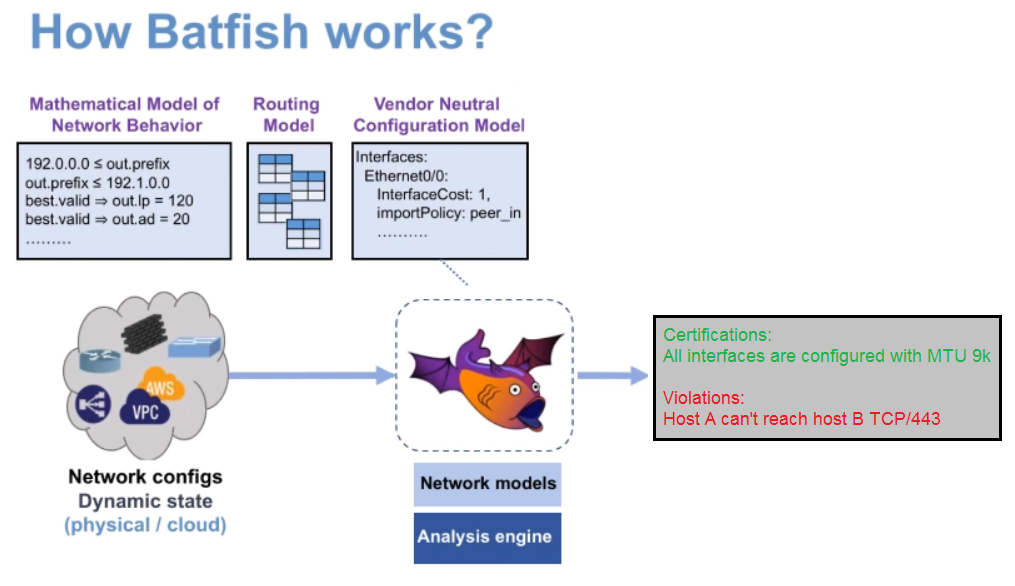
Batfish is a Java application. Pybatfish - python SDK was written for easy work with it.
Let's go to practice. I will show you the possibilities of Batfish by example.
Example
Under our management there are two autonomous systems: AS 41214 and AS 10631. IS-IS is used as IGP in AS 41214, and OSPF is used in AS 10631. Inside each AS is used IBGP-fullmesh. The LDN-CORE-01 announces the prefix 135.65.0.0/19 to its BGP neighbors, MSK-CORE-01 - 140.0.0.0/24. The exchange of routing information between autonomous systems occurs at the junction HKI-CORE-01 - SPB-CORE-01.
HKI-CORE-01, STH-CORE-01 - Junos routers
LDN-CORE-01, AMS-CORE-01, SPB-CORE-01, MSK-CORE-01 - Cisco IOS routers

Install the container with Batfish and python SDK:
docker pull batfish/allinone docker run batfish/allinone docker container exec -it <container> bash Let's get acquainted with the library through the interactive python mode:
root@ea9a1559d88e:/# python3 -------------------- >>> from pybatfish.client.commands import bf_logger, bf_init_snapshot >>> from pybatfish.question.question import load_questions >>> from pybatfish.question import bfq >>> import logging >>> bf_logger.setLevel(logging.ERROR) >>> load_questions() >>> bf_init_snapshot('tmp/habr') 'ss_e8065858-a911-4f8a-b020-49c9b96d0381' bf_init_snapshot ('tmp / habr') - the function loads configuration files into Batfish and prepares them for analysis.
/ tmp / habr - directory with the configuration files of routers.
root@ea9a1559d88e:/tmp/habr# tree . `-- configs |-- AMS-CORE-01.cfg |-- HKI-CORE-01.cfg |-- LDN-CORE-01.cfg |-- MSK-CORE-01.cfg |-- SPB-CORE-01.cfg `-- STH-CORE-01.cfg 1 directory, 6 files Now let's determine the status of BGP sessions on the LDN-CORE-01 router:
>>> bgp_peers = bfq.bgpSessionStatus(nodes='LDN-CORE-01').answer().frame() >>> bgp_peers Node VRF Local_AS Local_IP Remote_AS Remote_Node Remote_IP Session_Type Est_Status 0 ldn-core-01 default 41214 172.20.20.1 41214 sth-core-01 172.20.20.2 IBGP EST 1 ldn-core-01 default 41214 172.20.20.1 41214 ams-core-01 172.20.20.3 IBGP EST 2 ldn-core-01 default 41214 172.20.20.1 41214 hki-core-01 172.20.20.4 IBGP EST Well, how? Looks like the truth?
LDN-CORE-01#show ip bgp summary … Neighbor V AS MsgRcvd MsgSent TblVer InQ OutQ Up/Down State/PfxRcd 172.20.20.2 4 41214 629 669 9 0 0 00:56:51 0 172.20.20.3 4 41214 826 827 9 0 0 01:10:18 0 172.20.20.4 4 41214 547 583 9 0 0 00:49:24 1 Now let's see what IS-IS routes are in the RIB on the HKI-CORE-01 router according to Batfish:
>>> isis_routes = bfq.routes(nodes='HKI-CORE-01', protocols='isis').answer().frame() >>> isis_routes Node VRF Network Next_Hop Next_Hop_IP Protocol Admin_Distance Metric Tag 0 hki-core-01 default 172.20.20.3/32 ams-core-01 10.0.0.6 isisL2 18 20 None 1 hki-core-01 default 172.20.20.1/32 ams-core-01 10.0.0.6 isisL2 18 30 None 2 hki-core-01 default 172.20.20.2/32 sth-core-01 10.0.0.4 isisL2 18 10 None 3 hki-core-01 default 172.20.20.1/32 sth-core-01 10.0.0.4 isisL2 18 30 None 4 hki-core-01 default 10.0.0.0/31 sth-core-01 10.0.0.4 isisL2 18 20 None 5 hki-core-01 default 10.0.0.2/31 ams-core-01 10.0.0.6 isisL2 18 20 None At the command prompt:
showroute@HKI-CORE-01# run show route table inet.0 protocol isis inet.0: 18 destinations, 18 routes (18 active, 0 holddown, 0 hidden) + = Active Route, - = Last Active, * = Both 10.0.0.0/31 *[IS-IS/18] 00:51:25, metric 20 > to 10.0.0.4 via ge-0/0/0.0 10.0.0.2/31 *[IS-IS/18] 00:51:45, metric 20 > to 10.0.0.6 via ge-0/0/1.0 172.20.20.1/32 *[IS-IS/18] 00:51:25, metric 30 to 10.0.0.4 via ge-0/0/0.0 > to 10.0.0.6 via ge-0/0/1.0 172.20.20.2/32 *[IS-IS/18] 00:51:25, metric 10 > to 10.0.0.4 via ge-0/0/0.0 172.20.20.3/32 *[IS-IS/18] 00:51:45, metric 20 > to 10.0.0.6 via ge-0/0/1.0 Fine! I guess you have become clearer that there is a batfish.
At the beginning of the article I wrote that Batfish can be used to check configuration changes before they are entered into the “combat” network. Now I propose to consider the process of conducting network testing based on RobotFramework . For this, I wrote a small PyBatfish-based module that allows you to perform the following checks:
- Determine the status of BGP sessions on the network
- Determine the state of IS-IS neighbors
- Check for end-to-end connectivity between nodes on the network with trace demonstration
- Determine the size of the RIB on the router for a specific dynamic routing protocol
LibraryBatfish.py
import logging from pybatfish.client.commands import bf_logger, bf_init_snapshot from pybatfish.question.question import load_questions, list_questions from pybatfish.question import bfq from pybatfish.datamodel.flow import HeaderConstraints, PathConstraints from robot.api import logger class LibraryBatfish(object): def __init__(self, snapshot): bf_logger.setLevel(logging.ERROR) load_questions() bf_init_snapshot(snapshot) def check_bgp_peers(self): not_established_peers = list() bgp_peers = bfq.bgpSessionStatus().answer() for peer in bgp_peers.rows: if peer.get('Established_Status') != 'ESTABLISHED': not_established_peers.append(dict.fromkeys(peer.get('Local_IP').split(), peer.get('Remote_IP').get('value'))) if len(not_established_peers) == 0: return 1 else: logger.warn('BGP neighbors are not in an established state:') for neighborship in not_established_peers: for peer in neighborship: logger.warn('{} - {}'.format(peer, neighborship.get(peer))) return 0 def check_routes(self, node, protocol): routes = bfq.routes(nodes=node, protocols=protocol).answer() return len(routes.rows) def check_isis_neighbors(self, description): not_isis_enabled_links = list() for link in self._get_isis_enabled_links(description): if link not in self._get_isis_neighbors(): not_isis_enabled_links.append(link) if len(not_isis_enabled_links) == 0: return 1 else: for link in not_isis_enabled_links: logger.warn('{} {} has no IS-IS neighbor'.format(link.get('hostname'), link.get('interface'))) return 0 def ping(self, source_ip, destination_ip): ip_owners = bfq.ipOwners().answer() traceroute = self._get_traceroute_status(source_ip, destination_ip, ip_owners) reverse_traceroute = self._get_traceroute_status(destination_ip, source_ip, ip_owners) if traceroute == True and reverse_traceroute == True: self._show_trace(source_ip, destination_ip, ip_owners) return 1 else: logger.warn('Ping {} -> {} failed'.format(source_ip, destination_ip)) return 0 def _get_traceroute_status(self, source_ip, destination_ip, addresses): tracert = self._unidirectional_virtual_traceroute(source_ip, destination_ip, addresses) isAccepted = True if tracert != None: for trace in tracert.rows[0].get('Traces'): if trace.get('disposition') != 'ACCEPTED': isAccepted = False if isAccepted == True: return True else: return False def _get_paths(self, source_ip, destination_ip, addresses): tracert = self._unidirectional_virtual_traceroute(source_ip, destination_ip, addresses) traces = tracert.rows[0].get('Traces') paths = dict() path_number = 1 for trace in traces: if trace.get('disposition') == 'ACCEPTED': path = list() for hop in trace.get('hops'): path.append(hop.get('node').get('name')) paths[path_number] = path path_number += 1 return paths def _unidirectional_virtual_traceroute(self, source_ip, destination_ip, addresses): for address in addresses.rows: if address.get('IP') == source_ip: node = address.get('Node').get('name') int = address.get('Interface') headers = HeaderConstraints(srcIps=source_ip, dstIps=destination_ip, ipProtocols=['ICMP']) try: tracert = bfq.traceroute(startLocation="{}[{}]".format(node,int), headers=headers).answer() return tracert except: logger.warn('{} address has not been found'.format(source_ip)) def _get_isis_enabled_links(self, description='core-link'): isis_enabled_links = list() interfaces = bfq.interfaceProperties().answer() for int in interfaces.rows: if int.get('Description') != None and description in int.get('Description'): isis_enabled_links.append({'hostname' : int.get('Interface').get('hostname'), 'interface' : int.get('Interface').get('interface')}) return isis_enabled_links def _get_isis_neighbors(self): isis_neighbors = list() isis_adjacencies = bfq.edges(edgeType='isis').answer() for neighbor in isis_adjacencies.rows: isis_neighbors.append(neighbor.get('Interface')) return isis_neighbors def _show_trace(self, source_ip, destination_ip, addresses): logger.console('\nTraceroute to {} from {}'.format(destination_ip, source_ip)) paths = self._get_paths(source_ip, destination_ip, addresses) path_num = 1 for path in paths: n = 1 logger.console('\n Path N{}'.format(path_num)) for hop in paths.get(path): logger.console(' {} {}'.format(n, hop)) n += 1 path_num += 1 batfish-test.robot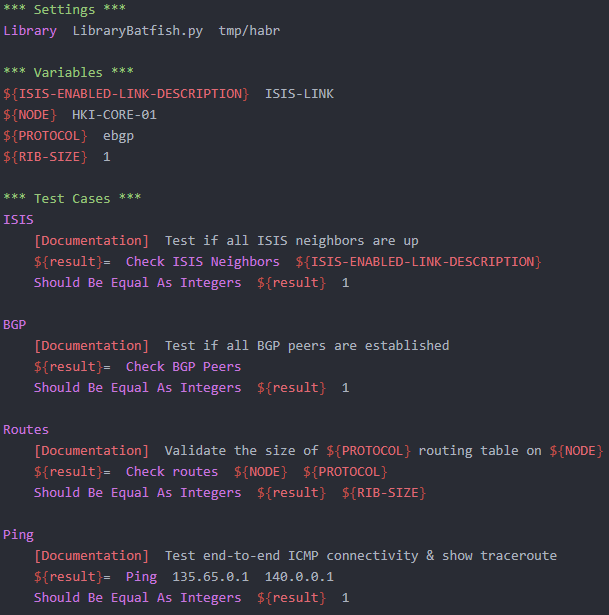

Scenario N1

Under my control is all the same network. Suppose I need to tidy up the filters on the border of AS 41214 and AS 10631 and block at the junction of packets containing the source or destination ip addresses from the BOGONS range.
Run the test before making changes.
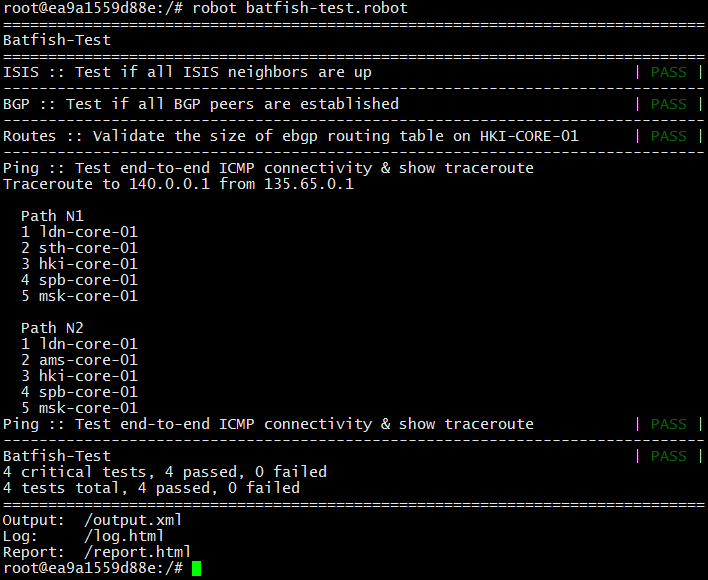
Tests passed.
Let's make changes to the test configuration of the HKI-CORE-01 router - /tmp/habr/configs/HKI-CORE-01.cfg:
set firewall family inet filter BOGONS term TERM010 from address 0.0.0.0/8 set firewall family inet filter BOGONS term TERM010 from address 10.0.0.0/8 set firewall family inet filter BOGONS term TERM010 from address 100.64.0.0/10 set firewall family inet filter BOGONS term TERM010 from address 127.0.0.0/8 set firewall family inet filter BOGONS term TERM010 from address 169.254.0.0/16 set firewall family inet filter BOGONS term TERM010 from address 172.16.0.0/12 set firewall family inet filter BOGONS term TERM010 from address 192.0.2.0/24 set firewall family inet filter BOGONS term TERM010 from address 192.88.99.0/24 set firewall family inet filter BOGONS term TERM010 from address 192.168.0.0/16 set firewall family inet filter BOGONS term TERM010 from address 198.18.0.0/15 set firewall family inet filter BOGONS term TERM010 from address 198.51.100.0/24 set firewall family inet filter BOGONS term TERM010 from address 203.0.113.0/24 set firewall family inet filter BOGONS term TERM010 from address 224.0.0.0/4 set firewall family inet filter BOGONS term TERM010 from address 240.0.0.0/4 set firewall family inet filter BOGONS term TERM010 then discard set firewall family inet filter BOGONS term PERMIT-IP-ANY-ANY then accept set interfaces ge-0/0/2.0 family inet filter input BOGONS set interfaces ge-0/0/2.0 family inet filter output BOGONS Run the test.
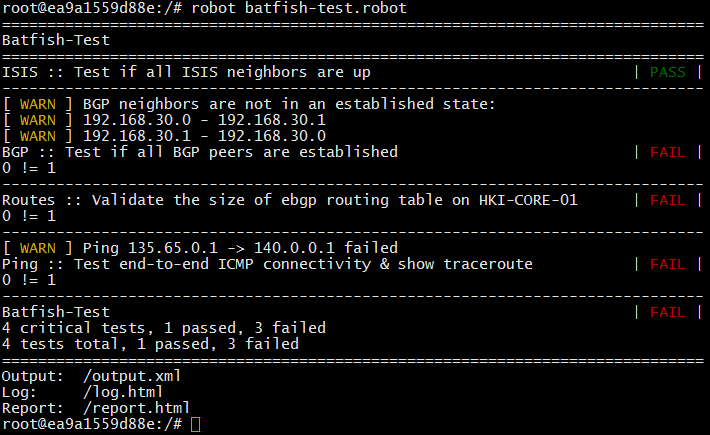
I was very close, but as the output of the test shows, after the changes made, the BGP neighborhood 192.168.30.0 - 192.168.30.1 is not in Established -> as a result, IP connectivity between points 135.65.0.1 <-> 140.0.0.1 is lost. What is wrong? We look closely at the HKI-CORE-01 configuration and see that eBGP peering is installed on private addresses:
showroute@HKI-CORE-01# show interfaces ge-0/0/2 | display set set interfaces ge-0/0/2 description SPB-CORE-01 set interfaces ge-0/0/2 unit 0 family inet filter input BOGONS set interfaces ge-0/0/2 unit 0 family inet filter output BOGONS set interfaces ge-0/0/2 unit 0 family inet address 192.168.30.0/31 Conclusion: it is necessary to change the addresses at the interface or add the subnet 192.168.30.0/31 to the exception.
I will add the network at the interface to the exception, I will again update /tmp/habr/configs/HKI-CORE-01.cfg:
set firewall family inet filter BOGONS term TERM005 from address 192.168.0.0/31 set firewall family inet filter BOGONS term TERM005 then accept Run the test.

Now unwanted traffic will not pass through the ebgp junction AS 41214 - AS 10631. You can safely make changes without fear of consequences.
Scenario N2

Here, I need to secure the network 150.0.0.0/24 on the MSK-CORE-01 router and ensure connectivity between points 135.65.0.1 and 150.0.0.1
I add the following lines to the test configuration of the MSK-CORE-01 router - tmp / habr / configs / MSK-CORE-01.cfg:
interface Loopback2 ip address 150.0.0.1 255.255.255.255 ! ip route 150.0.0.0 255.255.255.0 Null0 ! router bgp 10631 ! address-family ipv4 network 150.0.0.0 mask 255.255.255.0 ! I change the test script and run the check:
git diff HEAD~ diff --git a/batfish-robot.robot b/batfish-robot.robot index 8d963c5..ce8cb6a 100644 --- a/batfish-robot.robot +++ b/batfish-robot.robot @@ -5,7 +5,7 @@ Library LibraryBatfish.py tmp/habr ${ISIS-ENABLED-LINK-DESCRIPTION} ISIS-LINK ${NODE} HKI-CORE-01 ${PROTOCOL} ebgp -${RIB-SIZE} 1 +${RIB-SIZE} 2 *** Test Cases *** ISIS @@ -27,3 +27,8 @@ Ping [Documentation] Test end-to-end ICMP connectivity & show traceroute ${result}= Ping 135.65.0.1 140.0.0.1 Should Be Equal As Integers ${result} 1 + +Ping2 + [Documentation] Test end-to-end ICMP connectivity & show traceroute + ${result}= Ping 135.65.0.1 150.0.0.1 + Should Be Equal As Integers ${result} 1 Now I expect to see two eBGP routes on the HKI-CORE-01 router, as well as an additional connectivity check
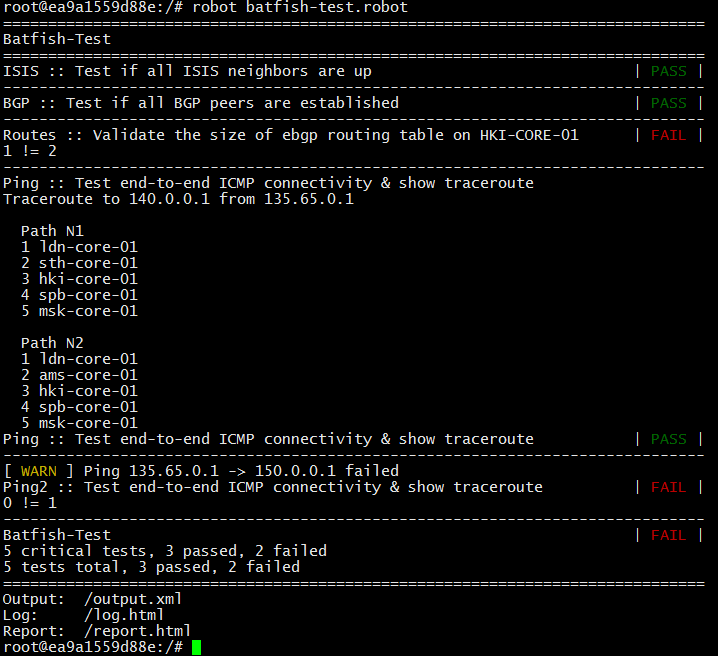
There is no connectivity between 135.65.0.1 and 150.0.0.1, moreover, there is only one eBGP route on the HKI-CORE-01 router, instead of two.
Check the contents of the RIB on the HKI-CORE-01 when adding a new configuration to the MSK-CORE-01 router:
showroute@HKI-CORE-01# run show route table inet.0 protocol bgp inet.0: 20 destinations, 20 routes (19 active, 0 holddown, 1 hidden) + = Active Route, - = Last Active, * = Both 135.65.0.0/19 *[BGP/170] 02:25:38, MED 0, localpref 100, from 172.20.20.1 AS path: I, validation-state: unverified > to 10.0.0.4 via ge-0/0/0.0 to 10.0.0.6 via ge-0/0/1.0 140.0.0.0/24 *[BGP/170] 01:38:02, localpref 100 AS path: 10631 I, validation-state: unverified > to 192.168.30.1 via ge-0/0/2.0 showroute@HKI-CORE-01# run show route table inet.0 protocol bgp hidden detail inet.0: 20 destinations, 20 routes (19 active, 0 holddown, 1 hidden) 150.0.0.0/24 (1 entry, 0 announced) BGP /-101 Next hop type: Router, Next hop index: 563 Address: 0x940f43c Next-hop reference count: 4 Source: 192.168.30.1 Next hop: 192.168.30.1 via ge-0/0/2.0, selected Session Id: 0x9 State: <Hidden Ext> Local AS: 41214 Peer AS: 10631 Age: 1:42:03 Validation State: unverified Task: BGP_10631.192.168.30.1+179 AS path: 10631 I Localpref: 100 Router ID: 10.68.1.1 Hidden reason: rejected by import policy Please note the import prefix policy received from SPB-CORE-01 :
set protocols bgp group AS10631 import FROM-AS10631 set protocols bgp group AS10631 neighbor 192.168.30.1 description SPB-CORE-01 set protocols bgp group AS10631 neighbor 192.168.30.1 peer-as 10631 set policy-options policy-statement FROM-AS10631 term TERM010 from route-filter 140.0.0.0/24 exact set policy-options policy-statement FROM-AS10631 term TERM010 then accept set policy-options policy-statement FROM-AS10631 term DENY then reject There is not a rule allowing 150.0.0.0/24. Add it to the test configuration and run the test:
showroute@HKI-CORE-01# show | compare [edit policy-options policy-statement FROM-AS10631 term TERM010 from] route-filter 140.0.0.0/24 exact { ... } + route-filter 150.0.0.0/24 exact; [edit] 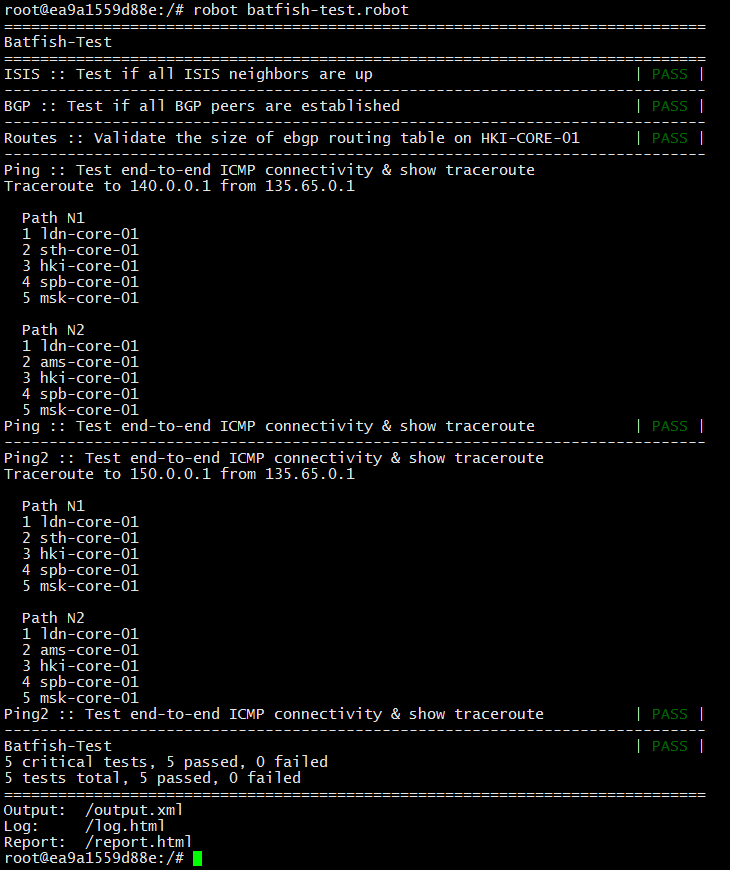
Great, there is connectivity between networks, all tests passed! So you can make these changes to the work of the "combat" network.
Conclusion
In my opinion, Batfish is a powerful tool with great potential. Try it and see for yourself.
If this topic is interesting to you, join the slack chat, Batfish developers will be happy to answer any questions and quickly fix bugs.
batfish-org.slack.com
Thank you for attention.
Links
www.batfish.org
www.youtube.com/channel/UCA-OUW_3IOt9U_s60KvmJYA
github.com/batfish/batfish
media.readthedocs.org/pdf/pybatfish/latest/pybatfish.pdf
github.com/showroute/batfish-habr
Source: https://habr.com/ru/post/441532/
All Articles